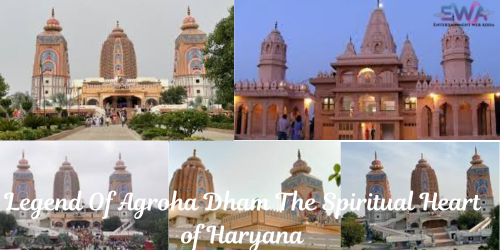Situated in the ancient town of Agroha in Haryana, Dham is a stunning spiritual and cultural monument. Dedicated to Goddess Mahalakshmi and named after the great Emperor Agrasen, this temple complex is a prominent place of pilgrimage that draws pilgrims from all over India. With its breathtaking architecture, rich history, and peaceful ambiance, Agroha Dham is not just a temple—it’s a testament to faith, prosperity, and heritage.

The Legend & History of Agroha Dham
The Ancient Link with Mahabharata & Emperor Agrasen
Agroha is of great historic importance, said to be the capital of the ancient Agrawal clan, established by the legendary King Agrasen. It was said to be a flourishing city in the Mahabharata period, and excavations have uncovered coins and objects thousands of years old.
The current Dham was founded in 1976 by the Agroha Vikas Trust to restore the spiritual and cultural heritage of the place. The temple is mainly devoted to Goddess Mahalakshmi, the goddess of wealth and prosperity, and Lord Shiva, with other gods of Hinduism.
Several legends and historical mentions connect this holy site with the history and characters of the times of the Mahabharata period. Let us see these incredible connections.
Click Here to Read About Secrets Of Saraswati River
Why is Agroha Temple Famous?
- Religious Significance: Followers feel that praying here grants blessings of success and prosperity.
- Historical Importance: Associated with the heritage of Agrawal community and medieval Indian kingdoms.
- Annual Festivals: Large events during Navratri, Diwali, and Mahalakshmi Puja draw gigantic crowds.
Nearby Attractions to Explore
- If you’re at Agroha Dham, do not miss these local attractions:
- 1. Agroha Mound (Archaeological Site)
- Ancient ruins that are thought to be the remains of the ancient Agroha city.
- Excavations have unearthed coins, pottery, and buildings dating to 300 BCE.
- 2. Sheela Mata Mandir (Taraori, 30 km from Hisar)
- A well-known temple of Goddess Sheela for its mythological legends.
- 3. Blue Bird Lake (Hisar, 20 km from Hisar)
- A beautiful attraction for picnicking and birdwatching.
- 4. Firoz Shah Palace & Fort (Hisar, 25 km from Hisar)
- A historical 14th-century fort constructed by Firoz Shah Tughlaq.
Agroha during the Mahabharata: The Agrasen Dynasty Lost City
As per Puranic literature and regional lore, Agroha was an erstwhile prosperous kingdom of the mythical King Agrasen, a Suryavanshi (Solar Dynasty) king who was thought to have been a contemporary of the Pandavas and Kauravas.
Important Associations:
✔ Mahabharata Period Kingdom: Agroha is referred to in ancient texts as “Agreya” or “Agrodaka”, a wealthy city which reportedly existed at the time of the Kurukshetra war.
✔ Connection to Emperor Agrasen: According to some scholars, Agrasen (forefather of the Agrawal community) was alive during the same period as the Mahabharata (3100 BCE or thereafter).
✔Archaeological Findings: Excavations close to Agroha have unearthed pre-Mauryan period coins, pottery, and buildings, affirming its ancient heritage.
The Pandavas’ Exile & Agroha’s Function
A lesser-known myth proposes that the Pandavas stopped by Agroha when they were in 12-year exile. According to some,
They sought refuge in the woods around Agroha.
A holy pond (kund) in Agroha Dham is credited to have been sanctified by Draupadi, who prayed at this location for prosperity.
3. Agroha & the Kurukshetra War
As Agroha is situated in Haryana—only 150 km away from Kurukshetra—it is likely that:
– Agroha warriors fought in the war.
– The city used to be a depot for food and arms.
– Post-war, Agroha could have been a centre for rehabilitation of displaced families.
